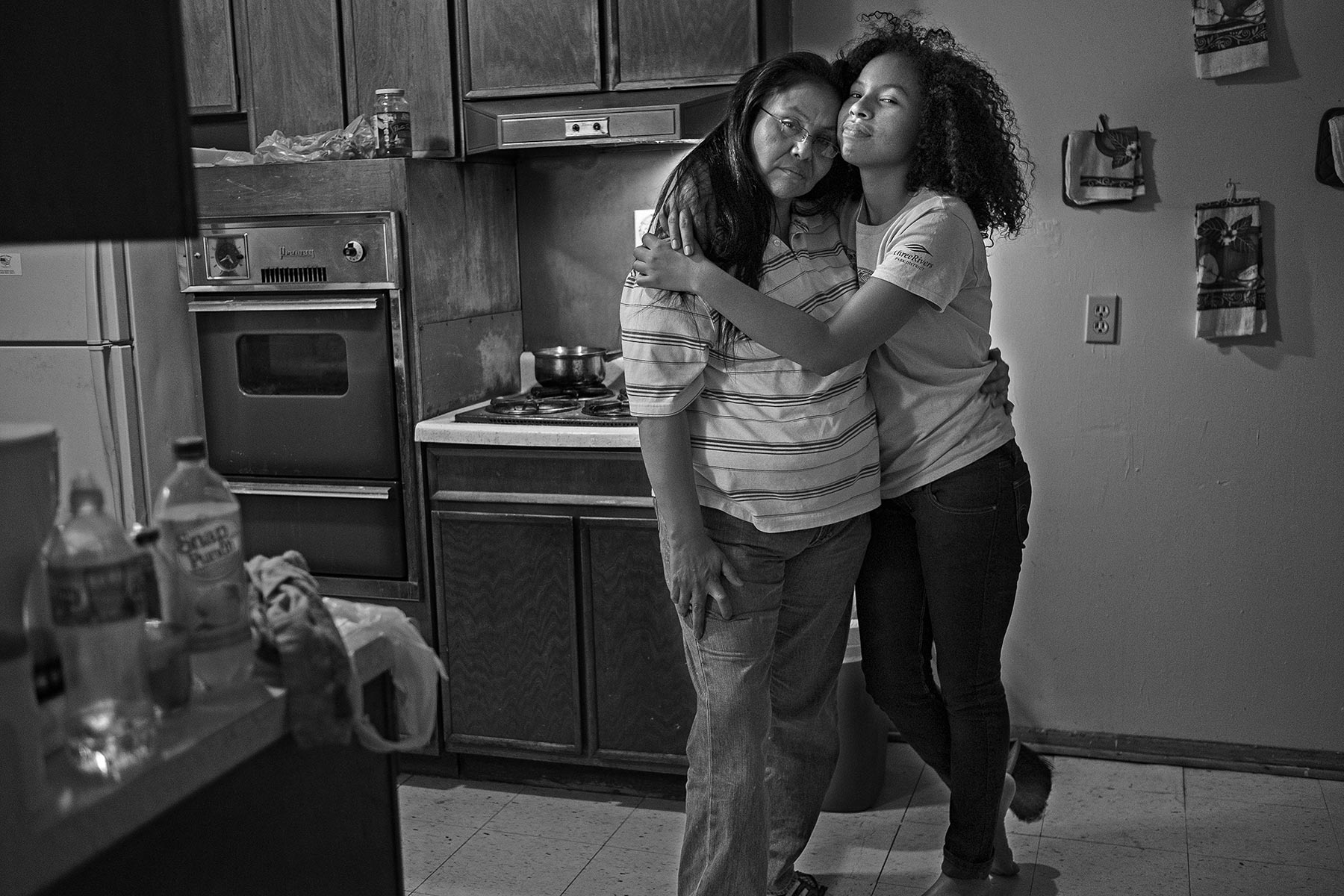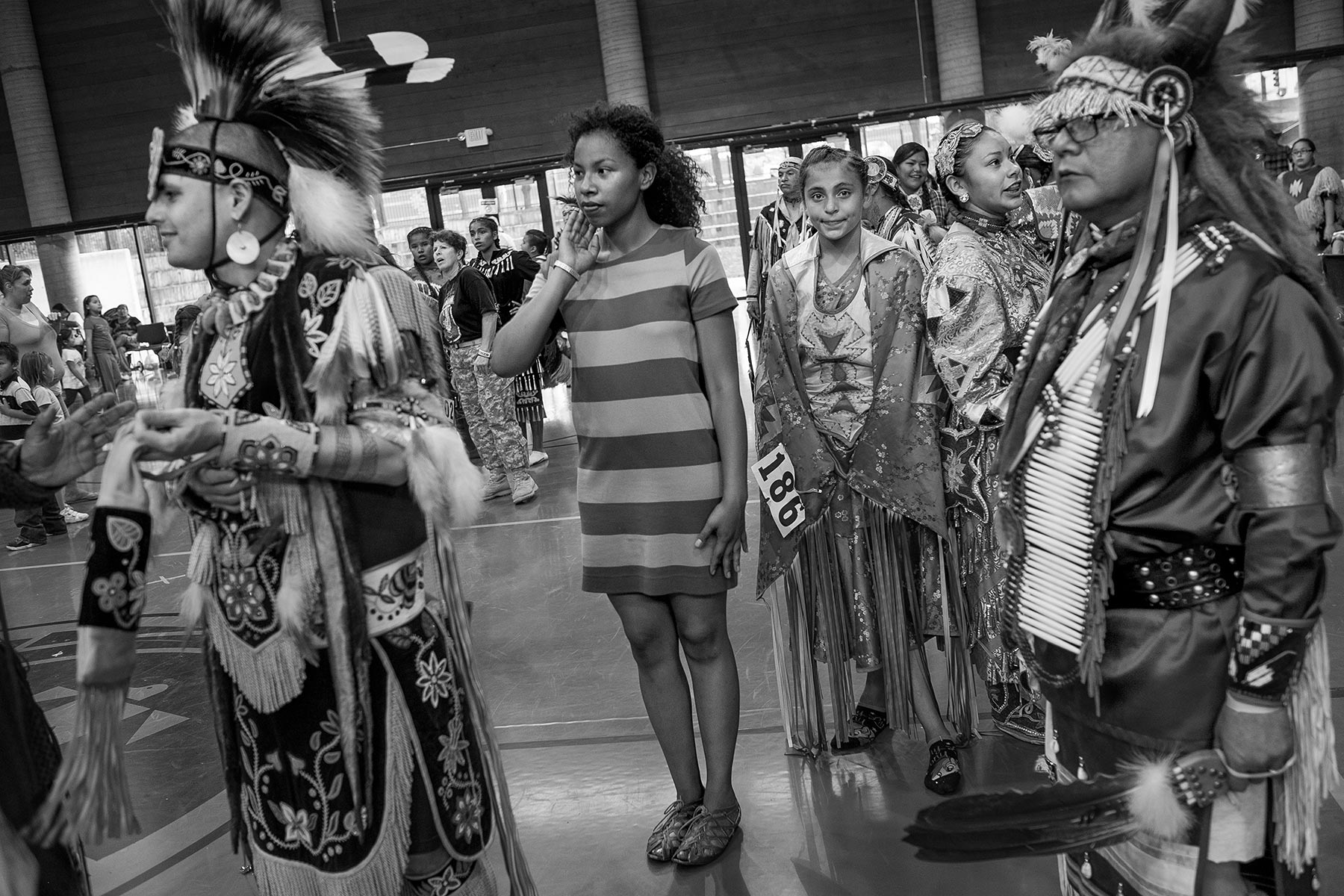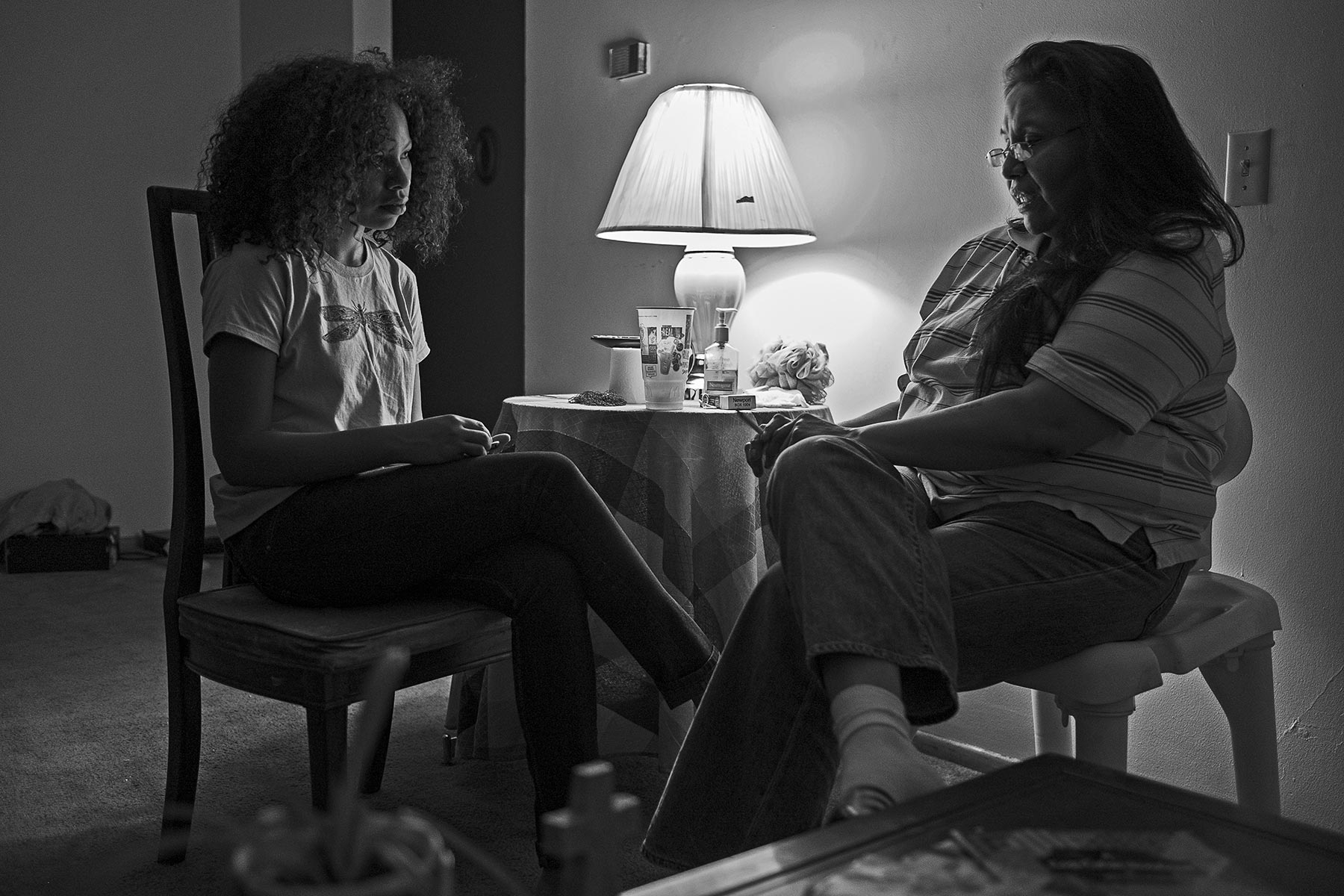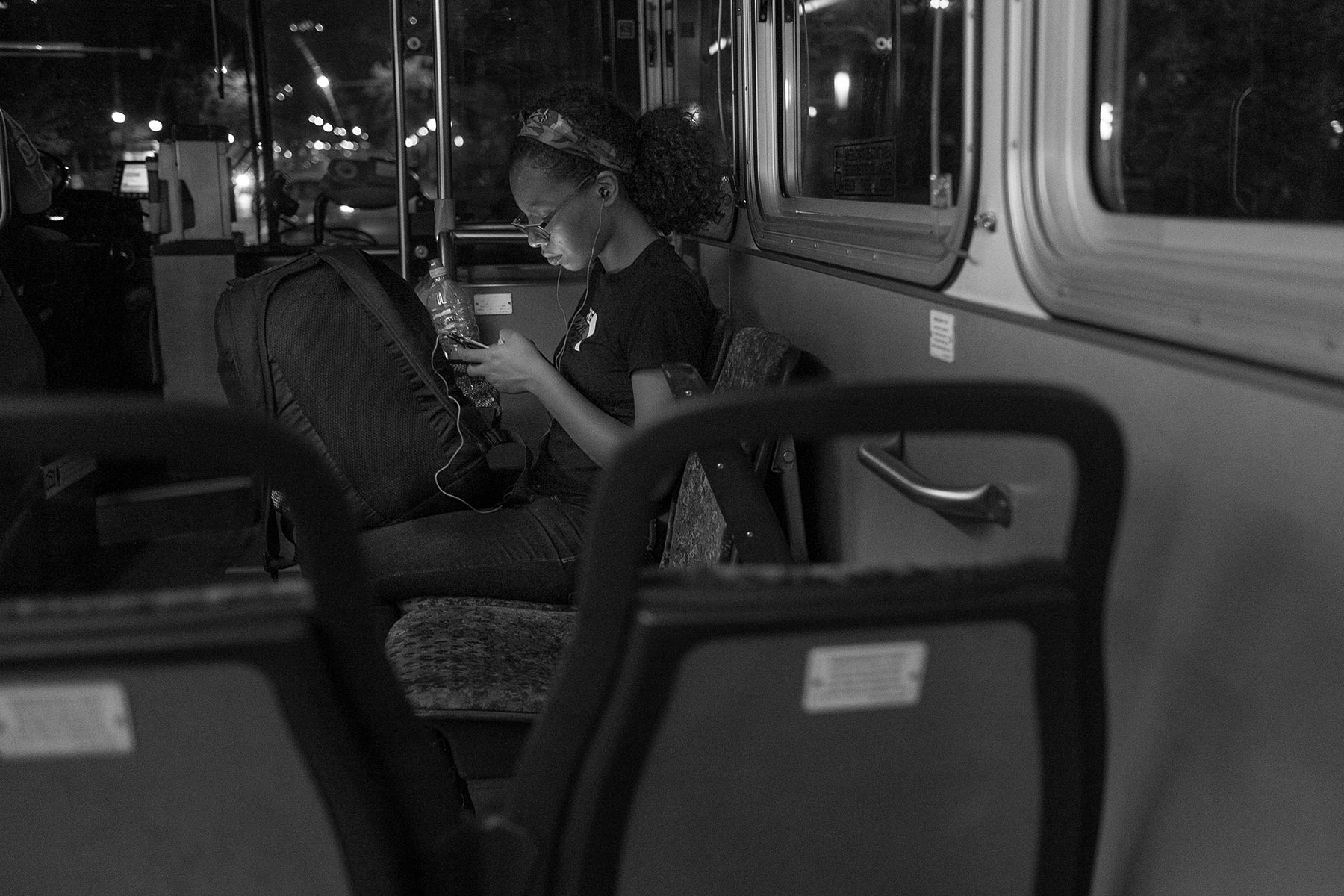
Priestess dreams
At 18, she's determined to make her way out
About this project
This is the second story in a five-part series on Native American gangs.
By Tristan Ahtone for Al Jazeera America
Photos by Tomo for Al Jazeera America
Edited by Mark Rykoff, Katherine Lanpher
Published on Tuesday, January 20, 2014
MINNEAPOLIS — It’s all kale salads, vegan Sloppy Joes and hip waitresses with tattoos and piercings in the front of the restaurant. In the back, where Priestess Bearstops works, it’s scrubbing, spraying, chopping and rinsing. Everything clangs so loudly, it’s tough to hear the roaring fan overhead or Beyoncé playing on the radio.
“I really want to be a server, but it’s hard trying to get a service job when you don’t have experience,” said Bearstops as she dunked a set of stainless steel pans into a sink full of soapy water. “On top of that, a lot of these chicks are all tatted up, and I’m not tattooed. They’re also predominately Caucasian.”
The 18-year-old Lakota tribal member paused for a moment, shook soapy water from her hands and used the back of her wrist to wipe sweat from her forehead. On a nearby wall, the restaurant’s menu was taped up. The morning brunch specialty: eggs Benedict, a dish Bearstops has never tried.
“It doesn’t matter to me,” she said as she began sorting silverware to throw into the industrial-strength dishwasher. “I’d just be washing that shit anyway.”
Four days a week, Bearstops ties back her long, curly hair, washes dishes and preps food, and every two weeks she gets a $400 paycheck. It’s a dead-end job, but it’s one of the safest places she could be. She says most of her peers are into drugs or have become enmeshed in gang life, and her home life can be just as unstable.
Every day, Bearstops has a choice: Minneapolis street life, the same life that claimed her little brother and still begs for her mother’s attention, or a life a little more ordinary — stable job, high school diploma, car payments, sleeping in an actual bed. She’s navigating a tenuous future in the city that gave birth to the modern Native American street gang.
“You can’t be around here vulnerable out in these streets because people will try you,” said Bearstops as she took a long drag off a Black & Mild cigar and exhaled a thick cloud of white smoke into the air.
Dusk was settling and she crossed her arms and looked down a tree-lined street in the East Phillips neighborhood on Minneapolis’ south side, just a short distance from her high school, American Indian OIC, an alternative school for Native students.
“This is where you’ll catch girls giving blow jobs in cars in alleyways; this is where you find that shit happening,” she said as she took another puff of her Black & Mild. “There are some families whose grandmothers did it, so that’s all they know. Some of my friends do that.”
Since World War II, Minneapolis’ Native American population — primarily from the surrounding Anishinaabe, Dakota and Ho-Chunk communities — has grown and flourished in the East Phillips neighborhood on the city’s south side, turning it into one of the most prominent urban Indian centers in America.
In the 2010 census, more than 7,500 Native people had addresses in Minneapolis, while more than 25,000 hailed from the Twin Cities metro area.
Around 61 percent of Native Americans in Minnesota are employed, while about 20 percent of homeless youth between 12 and 17 identify as Native American.
In Minnesota, nearly 20,000 students self-identify as Native American, and just under half of them graduate from high school.
“My mom was in treatment, and when she got out of that treatment facility, she came down here,” said Bearstops as she passed one of her old homes in East Phillips. “For a while she was sober and everything was good.”
However, Bearstops said her mother met a man who quickly moved in; then he began bringing his friends around, and in turn, they brought other people in.
“Pretty soon it’s not even my house anymore,” she recalled. “I saw that house go to shit in bits and pieces.”
Bearstops fought with her mother over the situation and ended up homeless soon after.
During that time she took up smoking cigarettes and weed — both of which she has now quit, save for the occasional Black & Mild — and threw a wrench in her high school career. Now 18, she is expected to graduate in 2015, a year later than what she had originally intended. She hopes to apply to the University of Minnesota after graduation and perhaps, someday, a place like Harvard.
The University of Minnesota was one of the first institutions to offer an American Indian Studies program, and organizations like the National Indian Education Association and American Indian Movement also owe their beginnings to the Mill City. Today, it’s one of the major organizing points for
Minneapolis’ Native neighborhoods are also blossoming with Native businesses, public art installations, a cultural corridor and thriving community resources ranging from health centers to housing services run for Indians by Indians. There are enough Native people walking the streets that they don’t seem out of place; they hang out in coffee shops, run art galleries and go about their daily lives.
Distrust of police is still part of daily life for the city’s Native American community. The American Indian Movement was born in Minneapolis in the 1960s because of police brutality in the Indian community, and in the 1990s, Minneapolis police arrested two intoxicated American Indian men and decided to transport them to a hospital in the trunk of their car.
With the collapse of the Somali government in 1991 and the ensuing civil war, refugees from East Africa have poured into Minnesota and made much of the city’s south side their home. One result of the newcomers’ arrival has been serious racial tensions that have escalated into violence in some cases.
In the 1980s, small street gangs began to form in East Phillips, groups with names like the Clubsters, whose primary purpose was protection against other small Native gangs and against non-Natives moving into the neighborhood. By the 1990s large, organized street gangs with years of experience, such as the Vice Lords and Gangster Disciples, began making East Phillips their home. For many Native youths, joining or forming new groups to fight established street gangs became the only options.
Bearstops has been living on Minneapolis’ north side for a few months, but still commutes south to go to school. However, living away from East Phillips hasn’t kept trouble away from her or her family. After becoming affiliated with the Pirus, a gang derived from the California Bloods, Bearstops’ 15-year-old brother, Priest, committed armed robbery twice, and is now in jail. Priestess’ mother, Reva Bearstops, has struggled continuously with substance abuse and faced numerous altercations with the law, job loss, a rotating cast of boyfriends and housing evictions.
“I want to get out of Minneapolis; I want to venture off and try new things and explore and travel,” said Bearstops. “I want to leave, but there’s always that notion in my head that says, ‘Who’s going to take care of your family?’”
Save for a couch, a coffee table, a television stacked on top of cardboard boxes and a large dream catcher mounted to the living room wall, the apartment was nearly bare.
Reva Bearstops and Priestess sat across from each other at a small, round side table supporting a lamp that had seen better days, a pack of Newports between them. Reva lit a cigarette.
“So, Mom, what brought you here?” asked Priestess. “By here I mean Minneapolis.”
There are a little over 500 miles between Minneapolis and the town of Wanblee on the Pine Ridge Reservation in South Dakota, which Reva Bearstops originally called home.
She left the Pine Ridge Reservation in the fall of 1988 because her cousin needed a ride to Minneapolis. Reva was 18 at the time, and had a 2-year-old daughter, Vicky, but agreed to drive. Once they arrived in the city, Vicky became ill and had to be hospitalized.
“My cousin begged me to drive her back to Wanblee, so I drove her back on the condition that she would bring me back up the next day,” Reva told her daughter. “She didn’t. So I ended up hitchhiking up here five days after I left my baby in the hospital.”
Once back in the city, Reva had no way to return to Wanblee but landed a job at a McDonald’s in Minneapolis and found housing. At the behest of her mother back in Pine Ridge, Reva stayed in the city.
“She wanted us to have better opportunities here in what she called white people’s land,” said Reva. “She never wanted us to stay on the reservation.”
According to the Department of Justice, between 1992 and 2002 Native Americans experienced violent crimes at double the rate of the rest of the nation; Native American women saw violent victimization more than twice as often as women overall; and around 60 percent of Native Americans who became victims of crime described their attackers as white.
According to the Government Accountability Office, between 2005 and 2009, more than half of all violent crimes in Indian country referred to authorities for prosecution were declined.
It’s realities like these that have kept Reva in Minneapolis instead of raising her kids where she grew up.
“A lot of my life wasn’t being like you kids were allowed to be,” said Reva to her daughter. “I was raised an adult.”
Reva said alcoholism was a fact of life in her household, and she was often left to fend for herself and her siblings.
“One time we didn’t have no food in the house and the kids were all hungry,” recalled Reva. “There was 11 of us, so I dug in the ground and I dug up a whole bunch of earthworms.”
She said she then went looking for eggs, but could only turn up a few blue robin’s eggs. She brought them home, built a fire and began cooking.
“The worms don’t sound good when they’re frying,” said Reva. “But I cracked the eggs over them and made scrambled eggs with earthworms.”
Reva took a drink from a plastic cup full of ice water. The ice clinked and knocked, and she looked her daughter in the eyes.
“I strive for you to be better than me, to do better,” she said. “That’s why for me it’s so important that you graduate from high school to do something more with yourself, to enhance your life as best you can. I know you can.”
Outside someone honked a car horn. Priestess sat motionless, listening to every word her mother had to say.
“You are my pride and joy,” said Reva. “I’m proud of you. And that’s something you should always know. I love you.”
“I love you too, Mom,” replied Priestess. “I love you too.”
Reva put out her cigarette and checked her phone.
Priestess Bearstops sat on a bus stop bench and took a swig of bottled water as the clock crept up on midnight. Dressed in a black shirt, black pants and black boots, she carried a backpack almost as big as she was.
“I have a lot of friends and associates that say I’m fake now because I’m not kickin’ it all the time,” said Bearstops. “So when I’m trying to do my classwork and maybe I’m not talking and gabbing with everybody, all of a sudden they’re like, ‘Oh, she’s fake.’”
The streets were empty, and Bearstops spotted the bus, then stood up to flag it down. The ride would take about 45 minutes, and by 8:30 the next morning she would need to be on the bus again in order to make it to school by 9:20.
Every day, Priestess Bearstops has a choice: a regular life, or a place on the streets. Many of her peers come from exactly the same background as she has and have made a very different decision, yet Bearstops has said no, and continues on.
“You get to a point where you realize that there’s so much more to life than the ’hood,” said Bearstops. “It’s not what I want for my life.”





